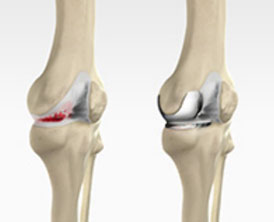Unicompartmental Knee Replacement

Partial Knee Replacement
What is a Partial Knee Replacement?
Partial Knee Replacement is also is known as Single Compartment, Unicompartmental or Unicondylar Knee Replacement.
Knee Replacement surgery is performed to replace damaged knee components with artificial implants, but only in the diseased part of the knee.
Your Knee Structure
Your knee can be divided into three compartments:
- patellofemoral, the compartment in front of the knee between the knee cap and thigh bone,
- medial compartment, on the inside portion of the knee, and
- The lateral compartment which is the area on the outside portion of the knee joint.
Sometimes the damage to your knee is limited to only one compartment.
Why Consider a Partial Knee Replacement?
Single Compartment or Unicompartmental Knee Replacement is a minimally invasive surgery in which only the damaged compartment of the knee is replaced with a new metal and plastic implant.
The healthy cartilage and bone in the remainder of the knee are left alone.
This means that only a part of the knee joint is replaced through a smaller incision than would normally be used for a total knee replacement. A Partial Knee Replacement preserves more bone and soft tissue compared to a Total Knee Replacement.
A Total Knee Replacement is indicated for severe osteoarthritis of the knee where many or all the knee joint surfaces or compartment are either worn out or damaged and require replacing.
Advantages of Partial Knee Replacement
The benefits of a Unicondylar Knee Replacement over a total knee replacement (TKR) are:
- tissue preserving operation with less bone removal,
- smaller incisions and faster recovery
- better overall range of movement
- Less blood loss
- Feels more like a natural knee
Symptoms of Knee Arthritis
Osteoarthritis is the most common form of knee arthritis in which the joint cartilage gradually wears away. It most often affects older people.
Arthritis of the knees can cause knee pain, which may increase after activities such as walking, stair climbing, or kneeling.
In a normal joint, articular cartilage allows for smooth movement within the joint, whereas in an arthritic knee the cartilage itself becomes thinner or completely absent.
Arthritic joint inflammation causes
- pain,
- swelling (inflammation),
- stiffness, and
- limiting the range of motion.
In addition, the bones become thicker around the edges of the joint and may form bony “spurs”. These factors can cause pain and restricted range of motion in the joint.
Knee deformities such as knock-knees and bow-legs may also occur.
Causes of Knee Arthritis
The exact cause is unknown, however, besides the wear and tear of age, there are several factors that are commonly associated with the onset of arthritis and may include:
- Injury or trauma to the joint
- Fractures of the knee joint
- Increased body weight
- Repetitive overuse
- Joint infection
- Inflammation of the joint
- Connective tissue disorders
Who is Suitable for Partial Knee Replacement?
Patients suitable for Partial Knee Replacement are those who are:
- suffering pain
- restricted mobility interferes with your lifestyle
- clinically proven to have only one diseased compartment (X-ray and MRI confirmed)
- not suffering from severe angular deformity
- not suffering inflammatory arthritis e.g. rheumatoid arthritis
- not suffering an unstable knee
- not previous osteotomy patients
While a partial knee replacement can be considered at any age, the outcome of the surgery tends to depend on the type of arthritis, rather than your age.
- younger patients would benefit from bone preservation which is helpful if you need revision surgery at a later stage, and
- older patients would benefit from a less stressful operation with less pain and less risk of bleeding
Diagnosis for Partial Knee Replacement
Your doctor will diagnose osteoarthritis based on your medical history, physical examination, and X-rays. X-rays typically show a narrowing of joint space in the arthritic knee and can identify the extent of joint damage and remediation required.
Partial Knee Replacement Approach
Partial or Unicondylar Knee Replacement has been performed for decades and developments in:
- implant design,
- instrumentation and
- surgical techniques
have all resulted in this approach being considered as the procedure of choice for single compartment unicompartmental knee arthritis.
Your doctor may recommend surgery if non-surgical treatment options such as medications, injections, and physical therapy have failed to relieve the symptoms.
Partial Knee Replacement Procedure
The procedure is designed to be performed with minimal local trauma
- a small incision around 7 cm is made to expose the knee joint,
- your surgeon will remove only the damaged part of the meniscus and joint to accommodate the new metal component
- trial components are then inserted and tested for accurate fit, stability and range of motion,
- The replacement components then placed into the new prepared area and are secured with bone cement,
- the knee is then carefully closed and
- the knee dressed and bandaged.
Once the new components are fixed in the proper place the knee is taken through a range of movements. The muscles and tendons are then repaired and the incision is closed.
Post-Operative Care
You may walk with the help of a walker or cane for the first 1-2 weeks after surgery.
A physical therapist will advise you on an exercise program to follow for 4 to 6 months to help maintain range of motion and restore your strength.
You may perform exercises such as walking, swimming and biking but high impact activities such as jogging should be avoided.
Risks And Complications
Possible risks and complications associated with unicompartmental knee replacement include:
- Knee stiffness
- Infection
- Blood clots (Deep vein thrombosis)
- Nerve and blood vessel damage
- Ligament injuries
- Patella (kneecap) dislocation
- Plastic liner wears out
- Loosening of the implant.

